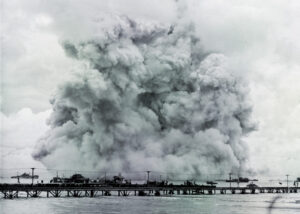What aircraft are naval aviation’s unsung heroes? Maybe it’s the antisubmarine force—planes and helicopters that guard against threats from the deep. Maybe it’s the onboard delivery transport that keeps carriers stocked with mail and supplies. Perhaps it’s the airborne warning and air traffic control planes that give the fleet its eyes or the electronic warfare craft that shield it. In Flight Deck 5 (FD5), you can fly them all.
Flight Deck 5 ($30, requires Microsoft Windows XP/Vista, 1 Ghz processor, 512MB RAM, 700MB hard drive space, 32MB DirectX 9 compliant video card, DVD-ROM drive, installation of Microsoft Flight Simulator version 2004 or X, Abacus, www.abacuspub.com) is an update to the popular naval aviation add-on for Microsoft Flight Simulator. Although a bit expensive for an add-on, the pack offers seven aircraft and dozens of new missions. Abacus also offers a discount for owners of Flight Deck 4.
The premise is simple. Practice carrier launches and landings in any of seven aircraft: the Boeing F/A-18C Hornet and F/A-18E Super Hornet; Northrop-Grumman EA-6B Prowler, C-2A Grey hound and E-2C Hawkeye; Sikorsky SH-60 Seahawk; and Lockheed S-3 Viking. FD5 also adds a talking landing signal officer (LSO).
Owners of the previous version might ask, “Is it worth the upgrade?” Virtual pilots running Flight Sim 2004 should probably wait until they are on board with Flight Sim X (FSX) to get their money’s worth out of FD5, which takes advantage of FSX’s mission support so fliers can enjoy goal-based play in addition to free flight. FD5 includes many missions, although there are only a few truly unique adventures. The majority are variations on carrier takeoff and recovery exercises. In FS2004 the carrier is static, but in FSX support for carriers that actually move boosts the authenticity.
This isn’t as much of a retread of mission types as you might think, due to the handling differences in each aircraft and the challenges of trapping in bad weather or at night. Still, it would have been nice to run some other mission types. Because FSX does not natively support combat, FS5’s makers had to be creative. The two missions with some bite to them are “Crisis in the East,” about a hypothetical strike mission using the Super Hornet, and “Day of the Water – spouts,” in which players make a dangerous trap in inclement weather.
Flight sims are becoming rare, and those with decent manuals rarer still. FD5 includes a 58-page guide to carrier aviation. There are bugs and issues with the pack. The total picture of carrier landings isn’t fully represented here because there doesn’t appear to be a functional “meatball” landing lens system. The talking LSO is an awesome interactive feature, but the LSO sometimes gave me instructions that were inaccurate or sudden, such as an abrupt “waveoff” call after having been told I was on the correct approach.
FD5 is a nice way to add a flattop’s complement to your digital hangar, but FSX players lacking Microsoft’s Acceleration expansion pack would probably be better served by looking into that first. It adds more features to FSX, includes the Hornet missions and has operational carrier landing aids (see the March 2008 “Airware”). FD5 adds more pure naval aviation variety and a chance to fly planes not found elsewhere. But if mission variety and a more authentic trapping experience are more important to you, FD5 is a bit less compelling compared to what the Abacus crew might do with Flight Deck’s next edition.
Originally published in the July 2008 issue of Aviation History. To subscribe, click here.




